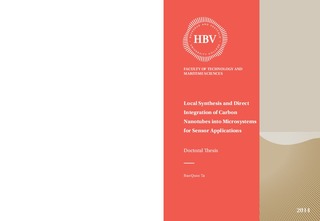| dc.contributor.author | Ta, Bao Quoc | |
| dc.date.accessioned | 2014-05-09T08:46:37Z | |
| dc.date.available | 2014-05-09T08:46:37Z | |
| dc.date.issued | 2014 | |
| dc.identifier.uri | http://hdl.handle.net/11250/194711 | |
| dc.description | Papers in this thesis are not available in this archive due to publishers' restrictions. | nb_NO |
| dc.description.abstract | Carbon nanotubes (CNTs) have been intensively studied since their discovery more than
two decades ago. A lot of research has exploited their extraordinary properties and various applications, meanwhile, revealed the challenges of fabricating the CNT-based device. Major challenges concern the high temperature required for the CNT growth, and the difficulty in handling and maneuvering the CNTs. An innovative approach to overcome these challenges is to locally synthesize and directly assemble CNTs into devices. Following such approach, this thesis developed a fabrication process with a high simplicity, a high controllability, and a CMOS/MEMS compatibility for the local synthesis and direct integration of CNTs into Si microsystems. This thesis covers the total process chain: from synthesis and integration of CNTs, to characterization, and to testing of a proof-of-principle gas sensor.
The first key finding of this thesis is a simple and robust method to control the temperature for the growth of CNTs by using only electrical signals. During the growth process, a localized hot region for the growth of CNTs is created by locally heating a Si microelectrode (Joule heating). The induced temperature is monitored through in-situ measurements of the electrical resistance of the Si electrode. The measured resistance provides feedback to control the input power for heating the Si electrode. This pure electrical control enables a simple, automated and parallel process to synthesize locally and integrate CNTs directly into microsystems.
The second key finding of this thesis is the diameter dependency for the effect of an applied electric field on the growth orientation of CNTs. A statistical analysis of 1100 CNTs showed that small-diameter CNTs (d < 5 nm) were straight and well-aligned with the applied electric field, whereas the large-diameter CNTs (d > 10 nm) were curved and did not align. In the transition regime, CNTs were moderately curved, but the average direction was at small angle with the electric field direction.
The third key finding of this thesis is the correlation between local temperature and resulting characteristics of CNTs. A high gradient of temperature along the Si microelectrode due to Joule heating allowed for studying the effect of temperature. At the region where the temperature is highest ( 900oC), the nanostructure of CNTs had the highest degree of order, and the average diameter of CNT was smallest. At regions with lower temperatures, CNTs had a higher degree of defects and disorder, and a lower average diameter. The density of CNTs, however, was highest at the moderate-temperature region ( 850oC).
The other contribution of this thesis is preliminary results on the development of CNT-based microsystems towards sensor applications. The preliminary results suggest that: (i) contact resistance at the CNT-Si interface could be reduced by both techniques of local annealing and local deposition of Platinum onto the CNT-Si contacts; (ii) thermal evaporation of metals could be used to functionalize the CNTs in a microsystem where CNTs are suspended and span two microelectrodes. | nb_NO |
| dc.language.iso | eng | nb_NO |
| dc.relation.ispartofseries | Doctoral theses at Buskerud and Vestfold University College;1 | |
| dc.relation.haspart | Paper 1: Ta, B. Q., Hoivik, N., Halvorsen, E., & Aasmundtveit, K. E. (2011). Electrical control of synthesis conditions for locally grown CNTs on polysilicon microstructure. IEEE International Conference on Nanotechnology (IEEE-NANO), 11, 374-377. doi: 10.1109/NANO.2011.6144351 | nb_NO |
| dc.relation.haspart | Paper 2: Bao, Q. T., Einar, H., Nils, H., & Knut, E. A. (2013). Diameter dependency for the electric-field-assisted growth of carbon nanotubes. Applied Physics Letters, 103, 123102. doi: 10.1063/1.4821437 | nb_NO |
| dc.relation.haspart | Paper 3: Bao, Q. T., Tormod, B. H., Nils, H., Einar, H., & Knut, E. A. (2013). Local synthesis of carbon nanotubes in silicon microsystems: The effect of temperature distribution on growth structure. Materials, 6(8), 3160-3170. doi: 10.3390/ma6083160 | nb_NO |
| dc.relation.haspart | Paper 4: Ta, B. Q., Nguyen, Q.-H., Hoivik, N., Halvorsen, E., & Aasmundtveit, K. E. (2012). Observations on defects and contact modes for locally grown CNTs. IEEE International Conference on Nanotechnology (IEEE-NANO), 12, 1-6. doi: http://dx.doi.org10.1109/NANO.2012.6322008 | nb_NO |
| dc.relation.haspart | Paper 5: Ta, B. Q., Ngo, A. V., Nguyen, Q.-H., Hoivik, N., Halvorsen, E., & Aasmundtveit, K. E. (2013). Deposition of Palladium on suspended and locally grown carbon nanotubes using thermal evaporation. IEEE International Conference on Nanotechnology (IEEE-NANO), 13, 1176-1179. doi: 10.1109/NANO.2013.6721053 | nb_NO |
| dc.relation.haspart | Paper 6: Aasmundtveit, K. E., Ta, B. Q., Lin, L., Halvorsen, E., & Hoivik, N. (2012). Direct integration of carbon nanotubes in Si microstructures. Journal of Micromechanics and Microengineering, 22(7), 1-6. doi: http://dx.doi.org10.1088/0960-1317/22/7/074006 | nb_NO |
| dc.subject | VDP::Teknologi: 500::Nanoteknologi: 630 | nb_NO |
| dc.title | Local Synthesis and Direct Integration of Carbon Nanotubes into Microsystems for Sensor Applications | nb_NO |
| dc.type | Doctoral thesis | nb_NO |
| dc.source.pagenumber | 82 | nb_NO |
